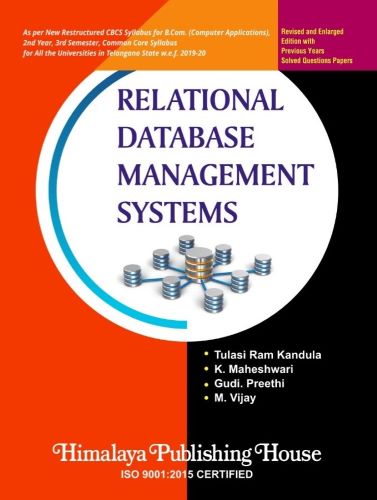Information is a crucial asset for any organization, enabling insightful analysis and strategic decision-making. While computer software provides efficient data processing capabilities, database systems are indispensable for effective data storage and retrieval.
This book presents a thorough exploration of the fundamentals of Database Management Systems (DBMS), balancing theoretical foundations with practical applications. It aims to make complex concepts accessible and useful for students. We delve deeply into the principles of database management, examining various data models and the specific advantages of relational models. Key topics such as entities, entity types, attributes, and relationships are explained with relevant examples and E-R diagrams.
Normalization, including its forms and constraints, is covered comprehensively to assist students in their academic preparations. The book also provides an extensive look at SQL, the essential language of databases, covering DDL, DML, and DCL commands with syntax and examples, including joins, indexes, and table handling techniques. Topics like transactions and concurrency management are explained with detailed examples to ensure a clear understanding. Additionally, the book addresses distributed databases, client-server databases, and advanced subjects like NoSQL databases and data warehousing to cater to the evolving needs of students.
Contents –
UNIT 1: BASIC CONCEPTS
1. Database Management System
2. File Oriented Approach
3. Advantages of DBMS over File System
4. Database Approach
5. Characteristics of Database Approach
6. Three Level Architecture of DBMS
7. Role and Functions Database Administrator (DBA)
8. Database Indexing
9. Data Dictionary
10. Types of Databases
11. Data Models
12. Relational Data Model
13. Object-Oriented Data Model • Candidate keys • Primary keys and foreign key for the Relations • Super keys
14. Relational Constraints • Key Constraints • Domain Constraints • Integrity Constraints
15. Constraint Violations
16. Relational Operations
17. Entity Relationship (ER) Model • Entities • Attributes • Relationship
18. Degree of Relationships
19. E-R Modeling for Database
20. Conversion of E-R Diagram to Relational Database
UNIT 2: DATABASE INTEGRITY AND NORMALIZATION
1. Relational Database Integrity
2. Keys
3. Entity Integrity
4. Referential Integrity
5. Redundancy and Associated Problems
6. Normalization • The First Normal Form (1NF) • The Second Normal Form (2NF) • The Third Normal Form (3NF) • Boyce – Codd Normal Form (BCNF)
7. Attribute Decomposition and Preservation • Lossless join Decomposition • Dependency Preservation Decomposition
8. Physical Database Design Issues
9. Storage of Database on Hard Disks
10. File Organization and Its Types • Heap/Unordered Files Organization • Sequential File Organization • Indexed Sequential File Organization / Indexed Sequential Access Method (ISAM) • Hash/Direct File Organization
11. Indexes
12. Tree Structure
13. Multi-key File Organization • Inverted File Organization • Multi-list File Organization
UNIT 3: STRUCTURED QUERY LANGUAGE (SQL)
1. SQL (Structured Query Language)
2. Data Types SQL
3. Elements of SQL Language
4. Operators in SQL
5. SQL commands
6. Data Definition Language (DDL)
7. Data Manipulation Language
8. Transaction Control Language
9. Data Control Language
10. Null Values in SQL
11. Where Clause
12. Like Clause
13. Order By Clause
14. Group By-having Clause
15. SQL Integrity Constraints
16. SQL Functions
17. Nested Queries
18. Joins
19. Views
20. Sequences
21. Index
19. Synonyms
UNIT 4: TRANSACTIONS AND CONCURRENCY MANAGEMENT
1. Transaction
2. Concurrent Transactions and Concurrency Control
3. Locking Protocol
4. Schedules
5. Two Phase Locking (2PL) Protocol
6. Deadlock
7. Optimistic Concurrency Control (OCC)
8. Database Recovery
9. Database Errors
10. Database Backup
11. Recovery Techniques
12. Confidentiality, Integrity and Availability of Database
13. Database Security
UNIT 5: DISTRIBUTED AND CLIENT-SERVER DATABASES
1. Distributed Database Systems
2. Need for Distributed Database Systems
3. Structured of Distributed Database System (DDS)
4. Advantages of DDBMS
5. Disadvantages of DDBMS
6. Advantages of Data Distribution
7. Disadvantages of Data Distribution
8. Data Replication
9. Data Fragmentation
10. Client-Server Databases
11. Advanced Topics in Database • Parallel Database • Multimedia Database • Mobile Database • Web Database • Multidimensional Database • Data Warehouse • OLTP Vs OLAP • NoSQL Databases
LAB: SQL QUERIES BASED ON VARIOUS COMMANDS
Previous Year Question Papers







